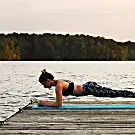Are you suffering in silence?

If anxiety is taking over your life, don’t despair. You can beat those inner demons
Headaches, hot flushes, persistent shaking and heart palpitations – these are just a few of the symptoms associated with anxiety, a debilitating condition that affects an estimated 3 million Brits on a day-to-day basis. ‘It is a feeling of unease or fear when faced with a situation that is perceived to be threatening or difficult. It is a normal, if unpleasant, feeling that everyone will experience from time to time, but it becomes a problem or makes life difficult when a person feels anxious all of the time or for no reason,’ says Nicky Lidbetter, CEO of charity Anxiety UK (anxietyuk.org.uk).
Over two-thirds of sufferers in the UK fail to seek treatment, according to a recent study by the British Acupuncture Council and Anxiety UK. ‘Many of us suffer in silence because we feel we should cope and soldier on with life. We’re also scared of being ridiculed or looked down upon,’ says psychologist Dr Lesley Parkinson. Worryingly, results from the recent study also revealed that two-thirds of sufferers put up with the condition for more than five years before getting help, even though they admitted it dominates important parts of their life, such as career and relationship.
Out of your depth
The rise in anxiety levels is thought to be underpinned by a range of factors – these days our lives are more stressful than ever, with money worries, relationship concerns, body woes and job-security issues placing an enormous amount of pressure on our shoulders. Wondering when you should seek help? If feeling like you can’t cope lasts beyond the onset of a specific stressful event, such as a looming work project or your upcoming wedding, it’s worth getting advice. ‘We need to feel comfortable about talking to others about how we are feeling. Anxiety is something many people are told to just get over, that they should just “pull themselves together”. But it is a recognised condition that if left untreated can lead to the person finding it difficult to cope,’ continues Nicky. Fortunately, there are many ways to help ease those heightened sensations of panic and fear. Try these strategies next time you’re in a stressful situation.
1. Get more sleep
If you’re not getting the rest you need, you’ll be more susceptible to anxiety and depression, according to a 2013 study by the University of California. Sleep deprivation ignites specific brain regions linked to our emotional activity, which encourages heightened feelings of anxiety.
Your rescue remedy: Get yourself into a proper bedtime routine every night. Soak in an essential oil-scented bath filled with calming oils like ylang ylang or lavender and enjoy a cup of valerian herbal tea to lull your body into a sleepy state.
2. Grin and bear it
It may sound silly, but putting on a happy face has an instant stress-relieving effect. Research by the University of Kansas found that smiling helps to lower heart rate and cortisol levels, which are key indicators of the body’s stress response.
Your rescue remedy: Need a little more happiness in your life? Try laughter yoga! Developed in India, laughter yoga blends breathing techniques with laughter exercises to help you feel more energised and revitalised. It’s thought that the body doesn’t know the difference between fake and real laughter, so you get the same stress-relieving effects whether your giggling session is for real or not. Who knew! Visit laughteryoga.co.uk for more info.
3. Clear out the clutter
Being surrounded by physical clutter is bound to have an impact on your mental clarity. Whether it’s an untidy workspace or living area, messiness can make it harder to relax and think about things rationally.
Your rescue remedy: Dedicating time to sorting out the space around you will have a positive knock-on effect on your headspace. Get a good filing system in order, de-clutter your living area and create a ‘zen’ corner with candles and beanbags where you can retreat to when the going gets tough.
4. Eat away the anxiety
It’s normal for appetite to change when you feel anxious. You might crave certain foods or go off eating altogether. Anxiety diminishes levels of vital vitamins, minerals and other nutrients that are important for good health, so it’s important to bolster up your intake to provide your body with the support it needs.
Your rescue remedy: Load up on energising B-vitamin foods like brown rice, nuts and seeds, omega-3 fatty acids, such as those found in oily fish including sardines and salmon, and tryptophan-rich foods like turkey and bananas, which promote feel-good emotions.
5. Breathe better
Breathing isn’t just about taking in oxygen and expelling carbon dioxide – learning breathing techniques can also help to prevent panic attacks and help you feel more balanced.
Your rescue remedy: Rapid, shallow breaths are our body’s natural reaction to a stressful situation, sending messages to our adrenal glands that we’re in danger. They then begin churning out stress hormones like cortisol which, when in excess, causes us to become imbalanced. ‘Taking five long, deep breaths is an incredible way to calm the mind. If you need something deeper, try alternate nostril breathing. Using your right hand place your thumb over your right nostril, index and middle finger rest between your eyebrows. Your ring and little finger should cover the left nostril. Closing the right nostril inhale gently through the left. Then close the left nostril and exhale through the right. Inhale again through the right then cover the right and exhale through the left. That is one complete round. Do this for five rounds,’ says yoga teacher Laurella Fox-Pitt (wildlaurel.blogspot.co.uk).
6. Learn to meditate
Taking time out to practise mindful meditation helps to fire up certain regions of the brain, according to a study by Wake Forest Baptist Medical Center in the US. The research found that there is a connection between meditation and the parts of the brain linked with anxiety relief.
Your rescue remedy: Meditation strengthens a person’s cognitive ability to regulate emotions, allowing us to give more space to the situation and not become so overwhelmed. ‘I recommend simply sitting cross-legged or in a chair and bringing your awareness to your breath. Watch it as it moves through the body, passing no judgement. Keep the breath natural and not too deep. When the mind wonders, acknowledge the thought and then gently bring the mind’s focus back to the breath,’ explains Laurella.
7. Make a plan
If life is getting on top of you, it’s time to get organised. Whether you’re worrying about a big work presentation you need to do or fretting about achieving your dream body, making a list of goals that you can tick off as you go along can be really helpful in helping to streamline your thoughts.
Your rescue remedy: If you’re a social media buff, sign up to Pinterest and start collecting and sharing pinboards to inspire you – they’ll also give you a sense of progress through imagery.
8. Move your body!
The connection between exercise and mental health is undeniable. Engaging in physical activity increases levels of the neurotransmitter GABA, which has a calming effect and helps to keep anxiety at bay, according to a study by Princeton University.
Your rescue remedy: Next time you feel stressed, lace up your trainers and go for a brisk walk or run. Or you could join a fast-paced class, such as Boxercise, at your local gym to help blast away any negative feelings. ‘Chemically, exercise releases feel-good endorphins that relax the mind and regulate moods, while the physical exertion can work as a distraction from day-to-day worries,’ says personal trainer Emma Pollard (emmapollard.com). ‘I’d suggest exercising for at least 30 minutes, three times a week, to feel the positive benefits.’
9. Get some needlework
Relaxation therapies, such as acupuncture, are particularly good for anxiety issues. In fact, research by the British Acupuncture Council and Anxiety UK, showed that the ancient Chinese practice could be used instead of prescribed medication to help the problem.
Your rescue remedy: Acupuncture sessions always seek to treat the root cause of the problem, which includes repairing any imbalances and strengthening energy. ‘When you suffer from anxiety, your mind can work at such a speed that you can’t think clearly and your natural distress signals are overworked, resulting in you feeling very vulnerable and scared,’ explains Mandy Laing, member of the British Acupuncture Council (acupuncture.org.uk). ‘Traditional acupuncture helps patients quieten thoughts and clear their minds, leaving them feeling stronger, emotionally, and enabling them to return to their “old self” again.’







